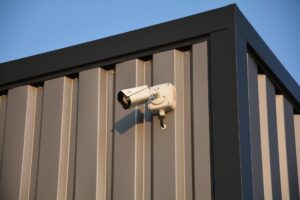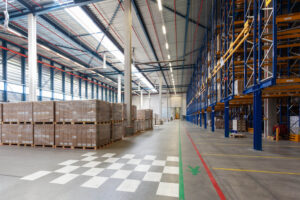If you’re managing a warehouse in Essex, you already know how important your location is. You’re at the heart of UK logistics, with fast connections to London and major ports like Tilbury. But this prime position also makes you a target for everything from organised crime to opportunistic thieves.
I’m going to walk you through the real security risks we see affecting Essex warehouses right now. My goal is to give you a clear, practical plan to protect your business based on what we’re dealing with on the ground every day.
How Big is the Warehouse Security Problem?
The problem is bigger than you might think, and it’s growing. Warehouses have become major targets for crime, leading to huge financial losses that can seriously damage a business.
To give you an idea, the average cost of a single data breach for a UK logistics business is now around £3 million. That number alone shows how serious the threat has become.
These trends affect warehouses of all sizes. Whether you’re running a small distribution centre in Chelmsford or a massive facility near Tilbury, criminals see an opportunity. And they are getting smarter about how they find and exploit weak spots.
Why is Warehouse Security in Essex Different?
Security isn’t a one-size-fits-all solution. Essex has its own unique challenges that a generic approach can miss, including local crime hotspots and specific risks you might not have considered.
What are the local hotspots for warehouse crime?
Certain industrial estates, like those in Basildon and Harlow, along with the areas around the Port of Tilbury, see specific types of criminal activity. These aren’t random break-ins; they’re often deliberate, organised operations.
At Tilbury, for example, gangs target goods moving in and out of the port. They know the schedules and understand security rotations. Meanwhile, other industrial parks might face more opportunistic thefts, often helped by inside information.
As one of our security experts puts it, “”Knowing that criminals target the outer lots of Tilbury at night, or that staff tip-offs are an issue in Basildon, is the kind of detail that makes a security system truly effective.””
Is it just about stopping thieves?
No, and this is where many warehouse managers get caught out. Some of the biggest threats to your operation aren’t criminal. Fire, flooding, and equipment failure can be just as devastating as a break-in.
Think about the chaos a major fire can cause. Beyond the loss of stock, your entire operation can be disrupted for weeks. During the cleanup and confusion, opportunistic thieves often take advantage of the situation. The fire creates a security gap that can be exploited long after the flames are out.
What about the threat from inside the building?
The insider threat from staff is a real and often underestimated problem. This is especially true with the high number of temporary staff used in Essex warehouses. It isn’t about being paranoid; it’s about being realistic.
We see serious issues with staff tip-offs and direct theft, particularly during peak seasons in busy hubs like Colchester and Chelmsford. When you bring in temporary workers, you’re inviting strangers into your facility. Without proper vetting and monitoring, you’re leaving your business exposed.
How Do You Build a Complete Security System?
A truly secure warehouse is protected by several layers of security that work together. These layers should cover your perimeter, your digital systems, and your people.
What’s the first layer of defence?
Your first layer is physical security—the things that keep intruders out or catch them if they get in.
The essentials are straightforward. You need high-definition CCTV that gives you clear images, day and night. You also need professionally monitored intruder alarms that ensure a response. Using smart access control with fobs or cards instead of keys lets you track who goes where and when. And don’t forget the basics. Strong physical barriers like proper fencing and bollards can stop a ram-raid before it happens.
What about the cyber threats?
Your next layer must be cybersecurity. If you think this doesn’t apply to warehouses, think again. Criminals now target Warehouse Management Systems (your software for tracking inventory) and other network devices to steal data or shut you down.
A ransomware attack can lock you out of your own systems. Imagine trying to start your week and finding you can’t access inventory, process orders, or even open the gates. Everything stops until you pay a ransom.
As one expert explained, “”Criminals no longer see a fence and a firewall as separate challenges. They see a single target. A USB stick dropped in a break room can be just as effective as a crowbar at 2 a.m.””
How do you handle the people problem?
Your final layer is your people. You need to make sure your team is a firewall, not a security hole.
This starts with thorough staff vetting for both permanent and temporary workers. Next comes security awareness training. Your team needs to know what to look for, from suspicious behaviour to phishing emails. If you use third-party security, make sure they are SIA-licensed. An unlicensed guard is often just a uniform with no real training behind it.
What Does a Security Breach Actually Cost?
The cost of a security failure goes way beyond the value of stolen goods. The real damage comes from downtime, harm to your reputation, and hidden costs that can impact your business for months.
First, there are the financial costs. Beyond the theft itself, a data breach can lead to large regulatory fines under GDPR. An attack might also cause your insurance premiums to double or triple.
The operational costs are what really hurt. When your warehouse is a crime scene, your supply chain grinds to a halt. It can take many months to fully recover from a major supply chain breach, causing long-term disruption.
Finally, there’s the damage to your reputation. If customers no longer trust you to keep their goods safe, winning new business becomes incredibly difficult. This is often the hardest damage to repair.
Here’s Your Simple 4 Step Plan to Get Started
You can start improving your security today. Follow these four simple steps to turn your warehouse from an easy target into a secure facility.
- Step 1: Get a Professional Risk Assessment. You can’t fix what you don’t know is broken. A professional audit from a local expert will identify the specific weak points that criminals in Essex look for.
- Step 2: Design Your Integrated System. Based on the assessment, design a system where your CCTV, alarms, and access control all work together. It’s not about buying the most expensive kit, but making sure it all connects to cover the gaps.
- Step 3: Implement and Train Your Team. Once the tech is installed, train your staff on the new procedures. The best security system is useless if an employee props open a fire door for a smoke break.
- Step 4: Review and Adapt. Security isn’t a one-time setup. Threats change and criminals adapt, so you need to review your system and procedures at least once a year to keep pace.
Don’t Wait for a Breach to Find Your Weak Spots
A proactive, layered security strategy designed for the Essex landscape is the only way to truly protect your business. Generic solutions won’t stop local criminals or prevent insider threats.
Waiting for an incident to happen is the most expensive strategy you can have. By the time a breach reveals your weak spots, the damage is already done.
Secure Your Essex Warehouse.
Don’t wait for a crisis. Contact AI Security today for a free, no-obligation site audit and let our local experts design a security solution tailored to your exact needs.
- Call us: 01702 476700
- Email: AIS.reception@ai-security.com
- Visit us: Vigilant House, 1155a London Road, Leigh-on-Sea, Essex, SS9 3JE”












